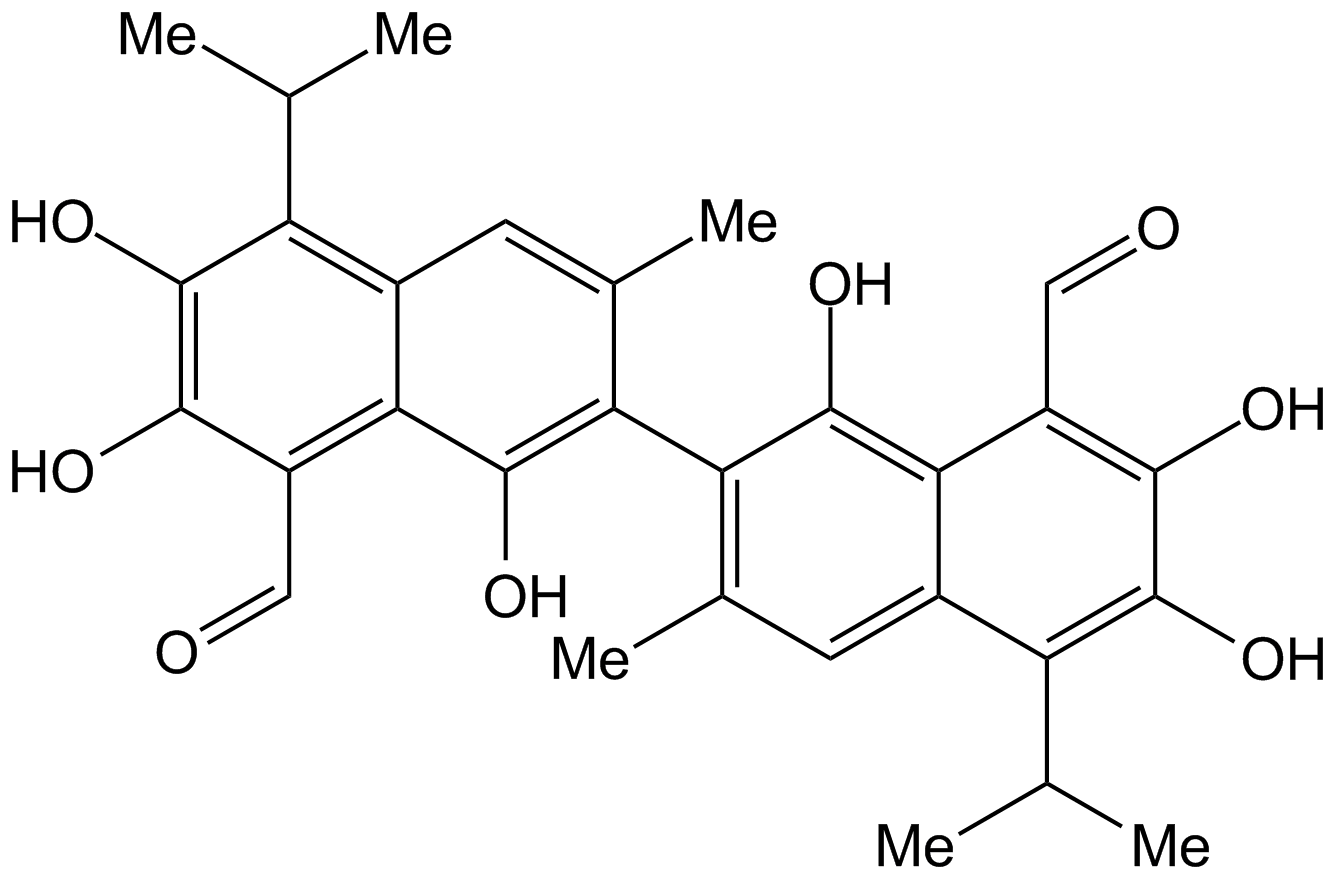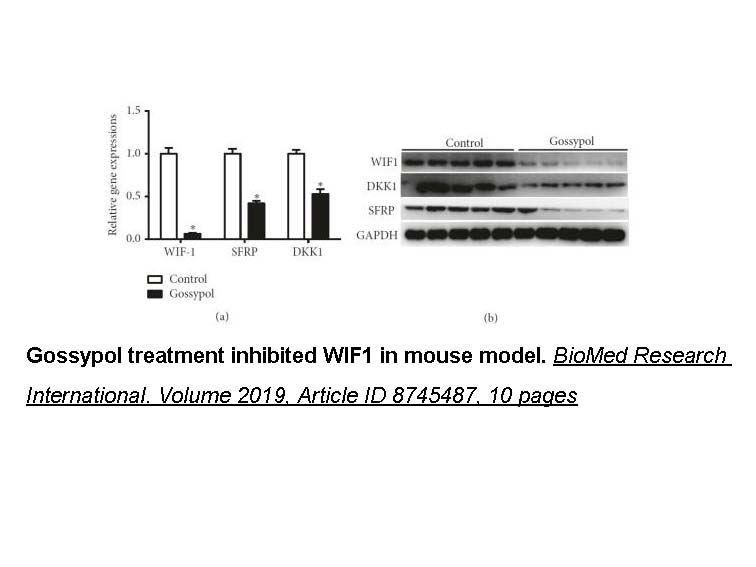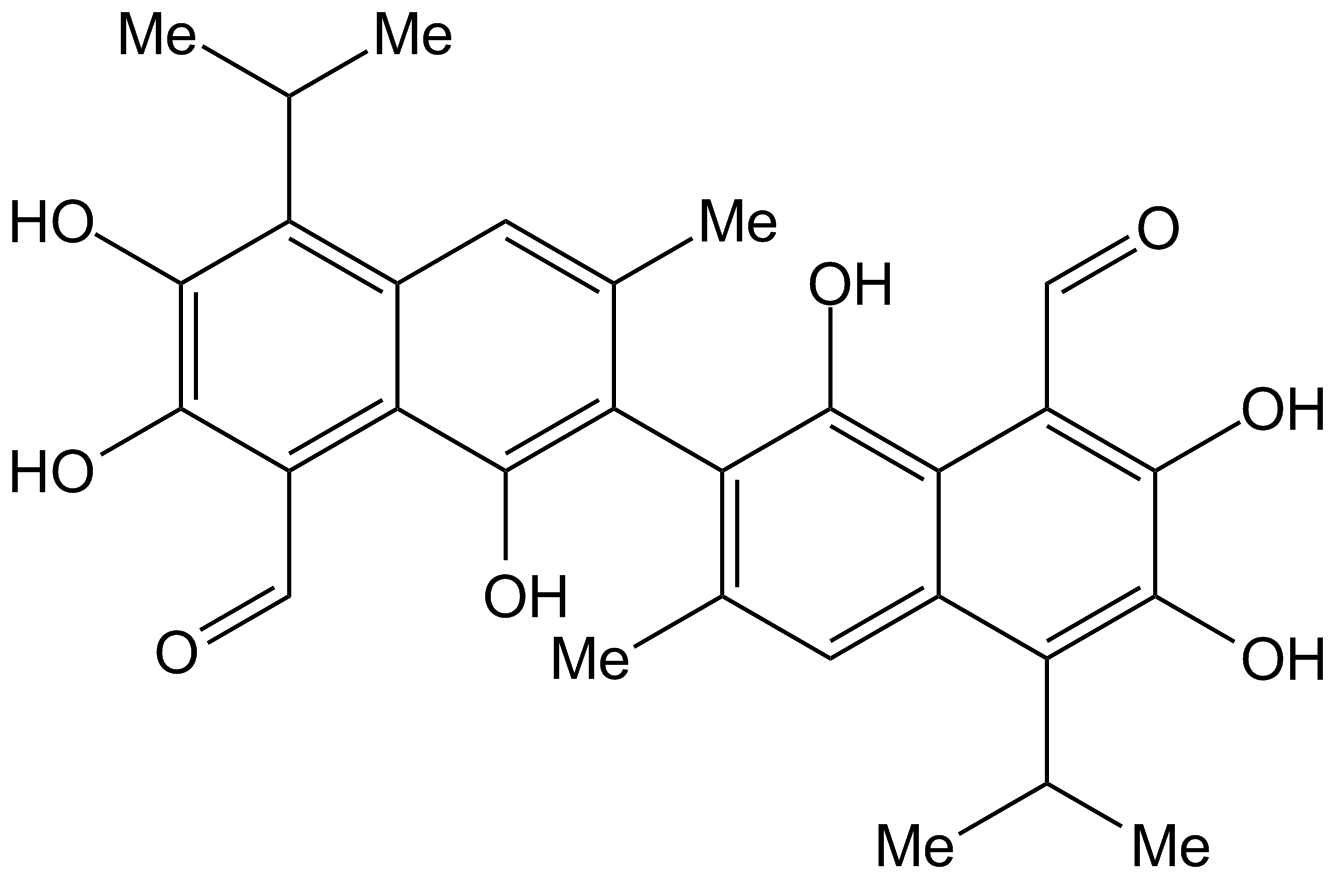Gossypol
Gossypol is a natural phenol compound derived from cotton stems, leaves, seeds, and flower buds.Gossypol has a 518.55 Dalton molecular weight and a yellow pigment. The most common toxic effectof Gossypolis the impairment of male and female reproduction. Another important toxic effect is its interference with immune function, reducing an animal’s resistance to infections and impairing the efficiency of vaccines[1].
In vitro: In bovine granulosa cells, treatment with gossypol dose-dependently decreased hCG-induced cAMP formation. Gossypol (12.5 μg/ml) inhibited basal cAMP level and progesterone secretion(2). Gossypol (50 and 100 μg/ml) decreased the percentage of sperm that completed the swim-up procedure. When cultured with5 or 10 μg/ml gossypol, development of cleaved embryos was reduced(3). In the lymphocytes isolated from lymph nodes of BALB/c mice, gossypol significantly inhibited the proliferation of mouse lymphocytes stimulated with phorbol ester plus ionomycin in a dose-dependent manner. Gossypol significantly suppressed the lymphoblastic transformation of both T and B lymphocyte subsets. Moreover, gossypol could induce apoptosis of lymphocytes in a time- and dose-dependent manner (4).
In vivo: In male Sprague-Dawley rats, gossypol (25 mg/kg, i.p.) caused marked changes in the activity of the hepatic and serum γ-glutamyltransferase (GGT) and microsomal monooxygenases (5). Rats that received lower gossypol doses (15 mg/kg/day for four weeks or 30 mg/kg/day for two weeks) showed morphological changes in the liver(6).
References:
[1]. Gadelha I C N, Fonseca N B S, Oloris S C S, et al. Gossypol toxicity from cottonseed products[J]. The Scientific World Journal, 2014, 2014.
[2]. Lin Y C, Coskun S, Sanbuissho A. Effects of gossypol on in vitro bovine oocyte maturation and steroidogenesis in bovine granulosa cells[J]. Theriogenology, 1994, 41(8): 1601-1611.
[3]. Brocas C, Rivera R M, Paula-Lopes F F, et al. Deleterious actions of gossypol on bovine spermatozoa, oocytes, and embryos[J]. Biology of reproduction, 1997, 57(4): 901-907.
[4]. Xu W, Xu L, Lu H, et al. The immunosuppressive effect of gossypol in mice is mediated by inhibition of lymphocyte proliferation and by induction of cell apoptosis[J]. ActaPharmacologicaSinica, 2009, 30(5): 597-604.
[5]. Deoras D P, Young-Curtis P, Dalvi R R, et al. Effect of gossypol on hepatic and serum γ-glutamyltransferase activity in rats[J]. Veterinary research communications, 1997, 21(5): 317-323.
[6]. Ying W, Hai-Peng L. Hepatotoxicity of gossypol in rats[J]. Journal of ethnopharmacology, 1987, 20(1): 53-64.
- 1. Liang J, Chen C, et al. "Gossypol Promotes Wnt/β-Catenin Signaling through WIF1 in Ovariectomy-Induced Osteoporosis." Biomed Res Int. 2019 Apr 21;2019:8745487. PMID:31139657
- 2. Liang J, Chen C, et al. "Gossypol Promotes Bone Formation in Ovariectomy-Induced Osteoporosis through Regulating Cell Apoptosis." Biomed Res Int. 2018 Dec 13;2018:3635485. PMID:30643801
| Physical Appearance | A solid |
| Storage | Store at -20°C |
| M.Wt | 518.55 |
| Cas No. | 303-45-7 |
| Formula | C30H30O8 |
| Solubility | ≥25.95 mg/mL in DMSO; insoluble in H2O; ≥2.1 mg/mL in EtOH |
| Chemical Name | 7-(8-formyl-1,6,7-trihydroxy-3-methyl-5-propan-2-ylnaphthalen-2-yl)-2,3,8-trihydroxy-6-methyl-4-propan-2-ylnaphthalene-1-carbaldehyde |
| SDF | Download SDF |
| Canonical SMILES | OC1=C(O)C(C=O)=C(C(O)=C(C2=C(C)C=C(C(C(C)C)=C(O)C(O)=C3C=O)C3=C2O)C(C)=C4)C4=C1C(C)C |
| Shipping Condition | Small Molecules with Blue Ice, Modified Nucleotides with Dry Ice. |
| General tips | We do not recommend long-term storage for the solution, please use it up soon. |
| Description | Gossypol is an inhibitor of platelet-activating factor (PAF). | |||||
| Targets | PAF | |||||
| IC50 | ||||||
Quality Control & MSDS
- View current batch:
Chemical structure

Related Biological Data

Related Biological Data








